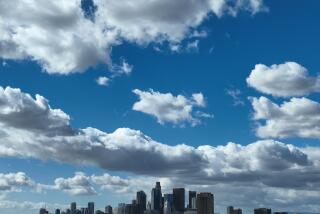Agency expects extreme summer drought
- Share via
Federal meteorologists expect “extreme” drought conditions this summer in Southern California, offering more bad news for firefighters who are already dealing with record dry weather.
The forecast by the National Oceanic and Atmospheric Administration dashed the hopes of some officials that the region’s bone-dry winter and spring would give way to a mild summer.
“We’ve gone from moderate to severe drought, and we’ve jumped to extreme,” said Bill Patzert, climatologist at NASA’s Jet Propulsion Laboratory in La Canada Flintridge.
The evidence is clear: Both Lake Mead and Lake Powell on the Colorado River are at half capacity, Patzert said. Downtown L.A. has received less than 4 inches of rain this year and is set to claim a record for its driest season.
“We can pretty much count on no rain into the fall,” said Miguel Miller, a meteorologist with the National Weather Service in San Diego.
This season’s dry spell has been caused in large part by a persistent high-pressure ridge over the eastern Pacific Ocean that has blocked many storms from hitting Southern California, Miller said. The few storms the region has experienced have fizzled because they came over land rather than over the ocean, he added.
Things won’t change this summer, Patzert said, noting that cooling temperatures on the eastern Pacific Ocean are leaving the region a weather pattern that brings drought conditions.
“We’re potentially looking at La Nina light,” Patzert said, dubbing it “the demon diva of drought.”
Drought conditions in Southern California have historically coincided with catastrophic wildfires, Patzert said.
Dry conditions in the late 1950s and early 1960s contributed to the Bel-Air/Brentwood fire of November 1961, which destroyed nearly 500 homes and prompted the first brush-clearance laws. The 1993 fires in Malibu and Laguna Beach, which also destroyed hundreds of homes, also came during a major drought.
Southern California has experienced numerous wildfires this winter and spring. Homes were destroyed in Malibu and Beverly Hills, while hundreds of acres were scorched in Orange County.
In just the last two weeks, firefighters had to deal with major blazes in Griffith Park and on Santa Catalina Island.
“It really brings home the point when people are talking about brush clearing,” Patzert said. “No matter who it is, homeowners, Caltrans or the city, the people better stop doing the pointing game and start doing the clearing game. We’re definitely in for it here.”
The effects of the dry conditions have been felt throughout the region. California’s poppies and other wildflowers did not bloom this year, putting pressure on the state’s beekeepers who rely on those flowers to make honey. Cattlemen are selling their cows early, their ranches too dry to grow natural grasses for cattle feed.
Still, many water agencies in Southern California have not called for water conservation, as underground storage and reservoir systems have improved since the drought of the late 1980s and the early 1990s.
During that drought, agencies promoted water conservation, leading restaurants to avoid serving drinking water unless customers asked. People stopped watering lawns, hosing down sidewalks and, at times, flushing toilets. But officials offer a grim long-term assessment. Southern California gets much of its water from outside sources, including the Colorado River and Northern California. The mountain snowpack vital to water imports from Northern California is at the lowest level in nearly two decades.
Several Central Valley and Northern California cities have imposed mandatory or voluntary water controls. On May 1, for example, Santa Cruz began prohibiting lawn watering from 10 a.m. to 5 p.m. In April, the San Francisco Public Utilities Commission asked its customers to curtail water use, warning about mandatory rationing this summer and fall.
*
More to Read
Sign up for Essential California
The most important California stories and recommendations in your inbox every morning.
You may occasionally receive promotional content from the Los Angeles Times.














